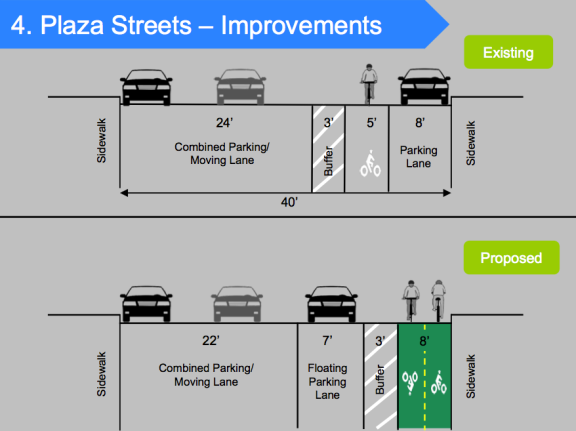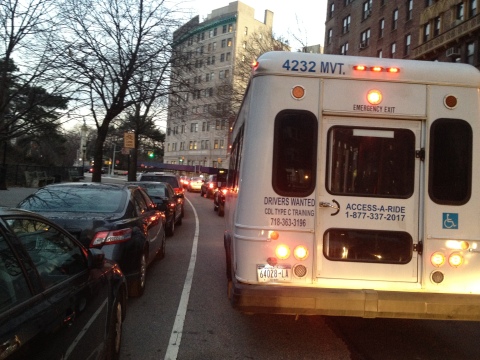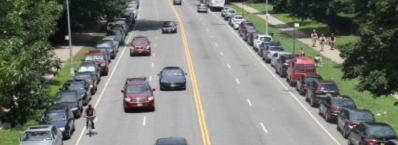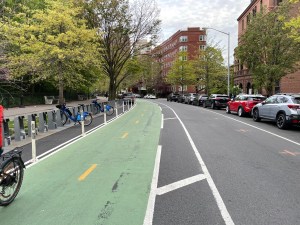The Case for a Two-Way Protected Bike Lane on Plaza Street
Cross-posted from Brooklyn Spoke.

In April 2010, DOT proposed an overhaul of the chaotic and dangerous Grand Army Plaza to include two-way protected bike lanes on Plaza Street East and West. (Plaza Street is not the high-speed roadway around the arch and fountain, but rather the less trafficked outer roadways, which already have one-way buffered bike lanes. Plaza Street is fronted on one side by residential buildings and on the other side by planted berms.) DOT’s proposal [PDF] used the existing footprint of the bike lane and parking lane, as well as two more feet from the very wide moving lane, to flip the parking lane and bike lane, putting a two-way bike lane against the berm side of Plaza Street, protected by parked cars — a design nearly identical to that of the redesigned Prospect Park West.
DOT’s Grand Army Plaza overhaul was eventually constructed in 2011 minus the protected bike lanes, some say as a result of the political blowback from the Prospect Park West bike lane lawsuit. With the suit now dismissed and the safety and congestion fears of bike lane opponents completely discredited, DOT will re-introduce a proposal for two-way bike lanes around Plaza Street. However, the Brooklyn Paper and other sources indicate that the city might propose two alternatives: one protected by parked cars, as in the 2010 plan, and one unprotected (yet still two-way). This is odd, given the phenomenal success of the Prospect Park West redesign; a meeting next week may be the public’s only chance to speak out for a well-designed, safe, protected bike lane on Plaza Street.
An unprotected two-way lane would essentially take over the existing bike lane’s footprint, with a painted buffer between the bike lane and moving vehicles and bright green paint on the bike lane itself, but would not alter the position of parked cars on the street. This presents a bit of a conundrum: how can DOT protect contra-flow cyclists from moving vehicles, and where does DOT expect cyclists to ride while the bike lane is blocked by double-parked vehicles, motorists awaiting parking spaces, and drivers (quite legally) entering and leaving parking spaces?
It appears that the unprotected proposal is, at least in part, a response to a few local residents’ concerns that relocating parked cars would narrow the roadway on Plaza Street and cause traffic backups every time someone double parks. But this concern fails on two levels. First, even with a protected bike lane, much of Plaza Street would still remain wide enough to accommodate a double parked vehicle and room for motorists to pass — and emergency vehicles could legally drive in a protected bike lane at any time if they needed to. Second, and perhaps more importantly, since when do we design our streets primarily to facilitate illegal and anti-social acts of double parking, as opposed to protecting our most vulnerable street users?
A protected bike lane would use the footprint of the existing bike lane and swap it with parked cars, still leaving room for motorists to safely pass double-parked vehicles.
Moreover, support for retaining a street wide enough for moving vehicles to speed around illegally double-parked vehicles is a tacit admission that motorists see bike lanes as extra space for their vehicles. They might generously extend to cyclists the privilege to occasionally ride in the bike lane when no driver happens to find it convenient to park in it or drive in it, but cyclists are really an afterthought. Because, of course, if we are to design our streets to allow double parking, then we expect double parking to happen often, and we expect motorists not to hesitate to go around the double parkers.
Herein lies the true issue with an unprotected design: if motorists double-park in the moving lane and keep the bike lane clear, other drivers will have to choose between waiting behind an idling car or using the bike lane as a passing lane. The more likely scenario is that motorists will idle in the bike lane, but in either case cyclists will find their path frequently blocked by motorists.
In the case of a one-way bike lane, cyclists are used to merging with vehicular traffic to maneuver around obstacles, but there’s no precedent for what happens when legal contra-flow cyclists with the right of way approach double-parked cars and have to negotiate with impatient motorists heading in the other direction. In many cases, contra-flow cyclists will actually be forced out into oncoming traffic.
Without a protected bike lane, contra-flow cyclists will find themselves riding head-on into speeding traffic using the bike lane as a passing lane.
The situation would be even worse on Plaza Street than on most streets: the curve of Plaza Street reduces visibility substantially, and double-parked vehicles would further limit this visibility. This curve is another reason why a curbside, parking-protected two-way bike lane is absolutely essential on Plaza Street. No sane parent would allow their child to confront these conditions by riding contra-flow in an unprotected two-way bike lane.
To my knowledge, no other two-way bike lane in New York City requires automobile drivers to cross the bike lane to enter and exit parking spots. (Is this design in use anywhere in the world?) The few on-street two-way bike lanes in New York are either parking-protected (like Prospect Park West and Kent Avenue) or curbside (like the short connector path between Ocean Parkway and Park Circle and the proposed two-way bike lane on Central Park’s 72nd Street transverse). And there are a number of barrier-protected paths, like those on Flushing Avenue. All of those paths work well and keep cyclists safe precisely because they actively prevent the mixing of cyclists with moving vehicles.

On Plaza Street cyclists would play chicken with drivers hundreds or even thousands of times a day: it would never be clear who had the right of way, the moving car or truck or the contra-flow cyclist forced into traffic by a blocked bike lane. Green paint alone does not, and cannot, resolve these conflicts. And impatient drivers already travel in the existing unprotected bike lane, creating an illegal extra vehicle lane at rush hour. This behavior, already dangerous, is not likely to change and could become tragic with contra-flow cyclists added to the mix.
We already know that a community-supported, two-way, parking-protected bike lane works phenomenally well on Prospect Park West, and in many ways Plaza Street is simply an extension of that bike lane and a vital connector to points north and west. We also know from experience all over the city that an unprotected path encourages conflicts with drivers seeking parking spaces, would inevitably be double-parked in, would likely be used by aggressively passing motorists, and in all of these ways would be unsafe for cyclists — and motorists.
Now we need to let the Community Boards and DOT know: no unprotected two-way bike lane for Plaza Street! Come stand up for a parking-protected design, similar to the wildly successful Prospect Park West bike lane, at the joint meeting of the Community Board 6 and 8 Transportation Committees:
Thursday, April 19, 6:30 pm
Turner Room, Prospect Park Residence
1 Prospect Park West (at Union Street)
Mike Epstein is a dedicated livable streets advocate, a member of Brooklyn’s Community Board 2, and serves on the board of Transportation Alternatives.

